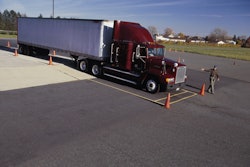Cargo theft has reached unprecedented levels in the U.S. transportation industry. This complex and evolving threat is one that the entire industry is working to address but one that still results in annual losses counted in billions of dollars. Opportunistic thieves, organized criminal enterprises, and cyber-enabled fraudsters have all discovered that the transportation supply chain is a target-rich environment.
The transportation and logistics industry are increasingly interconnected, but all too often is fragmented in its defenses. Across the industry, carriers, brokers, shippers and warehouse operators alike are investing in new technologies and designing new procedures to try to staunch the flow of losses. Through it all, we continually prove the same fact: There is no silver bullet.
Solving the cargo crime epidemic demands alignment across three interrelated spheres of responsibility: cybersecurity, operational security, and physical security. These are not separate silos; they are overlapping domains. Weaknesses in any one of these can compromise the others. In many cases of strategic cargo theft, attackers exploit all three simultaneously. The way out of this unprecedented cargo theft wave lies through an industry-wide, wholistic defense strategy that integrates cybersecurity, operational security, and physical security practices and couples that strategy with clear and effective communication between the different industry stakeholders, regulators, and law enforcement agencies.
Cybersecurity: the frontline in the fight against fraud
The modern cargo thief is equally likely to use a keyboard as a crowbar. Cybersecurity has risen from an afterthought to a central tool in the fight against cargo crime as our industry has increasingly come to depend on digital platforms for dispatching, inventory, and the booking of loads. Cyber-enabled cargo thieves are exploiting weaknesses in the security around the Federal Motor Carrier Safety Administration (FMSCA) accounts, transportation management systems (TMS), and email communications as well as good old-fashioned social engineering to impersonate legitimate carriers and brokers, steal independent driver’s identities, and reroute or “disappear” shipments.
Some of the more common cyber-enabled tactics include:
- Account Takeovers of carrier profiles and load board accounts.
- Phishing and Spoofing Attacks targeting brokers and dispatchers.
- Credential Stuffing from prior data breaches to gain access to TMS and Telematics Portals.
- Fake Carrier Registrations and MC number theft or purchase, and misuse.
- Business Email Compromise (BEC) targeting payment details and delivery instructions.
In order to effectively prevent these types of threats, transportation companies need to enforce robust cybersecurity controls across their operations, including strong identity and access management, the use of multi-factor authentication (MFA) and deploying endpoint and email security tools that can help to detect and prevent unauthorized access and reduce the risk of fraud. While technical controls are vital, staff training is equally important. Training for employees in load planning, customer service, or financial roles must teach them how to recognize and report suspicious digital behavior.
Operational security: process integrity as a defensive layer
Cybersecurity tools protect data and systems. Operational security practices determine how people interact with those systems and how business decisions are made. In nearly every cybercrime or cyber-enabled cargo theft, the damage is not the result of a technical exploit alone, but from lapses is verification procedures, an overreliance on trust, or fragmented communication between teams in the victim organization.
Key operational safeguards include:
- Strict vetting of carriers and brokers using multi-source identity checks, not just MC or DOT numbers.
- Ongoing monitoring of dispatch behavior, such as GPS deviations or unexpected gaps in tracking data.
- Standardized escalation procedures for unexpected delays or driver changes.
- Multiple verification steps before changing banking details or payment instructions.
- Logging and auditing of all dispatch and handoff decisions.
Operational security is the glue between digital systems and physical reality. It converts cybersecurity insights into defensible business workflows. In short, it is the human firewall to catch the red flags that digital systems and technical controls miss.
Physical security: anchoring protection in the real world
While cybersecurity and operational defenses work upstream to prevent fraud, physical security is still critical to keep cargo protected on the road, in drop yards, and on the docks. While any conversation about reducing cargo crime would be remise without mention of the physical security component, there has historically been a significant focus on the physical aspect of cargo security, and there is a large and extensive body of research available on the topic. For this reason, the NMFTA cybersecurity team is more narrowly focusing our research on the first two security practice areas: Cybersecurity and Operational Security. Ensuring that organizations have a comprehensive understanding of physical security safeguards is recommended. It is also noteworthy that many physical security controls increasingly depend on digital technologies —such as electronic door seals, RFID-based gate systems, and automated dispatch kiosks.
The call for convergence
The most effective cargo thieves—and therefore the costliest to the industry—are those that exploit the intersection between cybersecurity, operational security, and physical security. A stolen password might lead to an account takeover, which allows a criminal to impersonate a legitimate carrier. This results in a driver arriving at a shipper with falsified credentials or altered vehicle identification—and no one catching the discrepancy until the load has already vanished.
Addressing all three of these spheres of security responsibility in concert is essential. Controls must be designed in a way that supports and reinforces all three spheres. For example:
- Cybersecurity systems should trigger alerts to operational staff when login patterns or IP addresses associated with existing accounts are abnormal.
- Operational procedures should require physical verification of data received through security digital systems before cargo is released.
- Physical device telemetry should be encrypted and authenticated, not just passively collected. Gaps in GPS tracking should trigger operational security procedures for immediate follow-up.
This converged approach to cargo security supports resilience. When one layer is compromised—a stolen password, a spoofed email, a broken gate—the others can act as a failsafe. However, this only works if each layer is designed to be aware of the others and to support a holistic approach to security across all layers. This approach borrows from the defense-in-depth concept common in cybersecurity.
In the same way that no single control can prevent all cargo crime, no single stakeholder in the transportation and logistics ecosystem can shoulder the burden of solving the cargo crime epidemic alone. Carriers, brokers, shippers, facility operators, technology providers and law enforcement all have roles to play—and those roles must be aligned.
Brokers must vet carriers not just for insurance and capacity, but also for digital identity hygiene. Carriers must enforce internal cybersecurity training and control access to accounts like their FMCSA profile and dispatch systems. Shippers must require physical chain-of-custody verification and implement secure facility protocols. Technology vendors must build security into their tools by default, not bolt it on as an afterthought. Law enforcement must facilitate clear communication and collaboration across agencies and jurisdictions and partner with associations and industry stakeholders throughout the transportation supply chain to effectively combat cargo crime and provide threat intelligence to the industry.
Cargo crime is not a single-problem, single-solution challenge. It’s a multifaceted threat that evolves as quickly as the systems it targets. From hacked load boards to spoofed dispatch instructions, modern theft tactics cross technical, procedural, and physical boundaries. That’s why the industry cannot rely on the idea of a one-size-fits-all solution and instead must invest in an integrated security strategy—one that brings cybersecurity, operational discipline, and physical safeguards into deliberate alignment.
Each security sphere must rely on the others. Cybersecurity controls can’t prevent theft if load assignment processes are sloppy. Operational diligence can fail if physical locks are weak, or GPS trackers are vulnerable. No amount of steel and surveillance can stop a fraudster with access to TMS credentials. The solution lies not in any one tool, technology, or policy, but in the orchestration of them all. When cybersecurity reinforces operational integrity, and operational practices ensure that physical controls are applied and verified, the entire system becomes more resilient. Not perfect—but significantly harder to exploit.
There is no silver bullet. Only a collaborative, and converged approach can meaningfully reduce and mitigate this systemic threat.
Access free resources and learn more about the trucking industry’s only cybersecurity conference, NMFTA Cybersecurity Conference, by visiting www.nmfta.org/cybersecurity.














